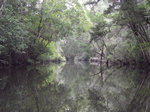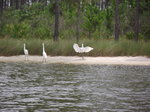FOLEY — As waterfront property becomes more developed, groups of local residents are working to preserve natural shoreline and water quality.In southeast Baldwin County, Wolf Bay Watershed …
This item is available in full to subscribers.
Please log in to continue |


FOLEY — As waterfront property becomes more developed, groups of local residents are working to preserve natural shoreline and water quality.
In southeast Baldwin County, Wolf Bay Watershed Watch members conduct water quality tests and works to educate young people about the importance of maintaining the area's ecology. The group held its annual meeting Saturday, Jan. 28, at the Graham Creek Nature Preserve in Foley.
The group is working to expand its monitoring program that tests the bay and surrounding streams, said Jackie McGonigal, water quality monitor trainer. The watch recently reactivated four testing sites and added two more.
"We always need monitors," McGonigal said. "It's the only way we can get baseline water-quality data, and without that base-line data there's no way to track water quality trends. So, we really need people to volunteer, take on sites."
Volunteers can sign on at the Alabama Water Watch website. The Alabama Water Watch also keeps track of the data collected in the Wolf Bay area and across the state, she said.
"I can't stress how important it is," McGonigal said. "Without having that baseline data, it's really hard to know what is happening in our watershed."
McGonigal, who is also Orange Beach Wind and Water Center coordinator of coastal resources, said recent tests indicate that water quality in some areas is deteriorating.
"In a nutshell, water temperature and turbidity, how cloudy the water is, that has been trending up, which is not great," McGonigal said. "There are a multitude of reasons for it. But those are things that are really important to know because I think a lot of water-quality issues that we're seeing can only be corrected if our local policy makers know about them."
Members also discussed preserving the waterfront area. Leslie Gahagan, Wolf Bay Watershed Watch president, said local officials and volunteers are working to acquire large parcels of waterfront property using funds from the Gulf of Mexico Energy Security Act, known as GOMESA.
The GOMESA program gives money to the four states that allow oil and gas production in the Gulf of Mexico. The states and coastal counties, parishes and cities share 37.5% of the qualified revenue from oil and gas leases in the Gulf.
In Alabama, the Department of Conservation and Natural Resources administers the distribution.
Patti McCurdy, ADCNR state lands director, said any land acquisition requires that a property owner agree to sell their parcel for a set value. The state cannot condemn property for conservation purposes.
She said the acquisition process can require negotiations.
"Does the landowner think that their land is worth more than appraised value? That gets into territory for the state where it's hard for us to operate because we're looking at appraised value," McCurdy said. "If you're looking at a landowner who owns a big piece of land, but they may want to keep some. They may not need all of it. Would they accept selling you less than the whole, but they probably want to get rid of the whole. So, there are a lot of questions. A lot of due diligence and a lot of strategy, but we are very, very hopeful on that."
Watch member Randy Kurtz said he is also working on an effort to recommend a 63-acre parcel for inclusion in the state Forever Wild program.
"It's over 40-foot elevation change from the road down to the water," Kurtz said. "I think it would be great to get this land preserved. This is one of the last buildable lands. All the rest is mostly wetlands and such as that, tidal. The upper two-thirds of this is buildable."
That project could also involve the use of GOMESA money to buy the property.
McCurdy said acquiring land for Forever Wild would also require agreements with the property owner that the site would be sold for the appraised value. She said many owners of waterfront property want a higher price for their land than the appraisal.
Another project discussed at the meeting was an effort by area property owners to restore shoreline in the area of Hammock Creek. Property owner Andrew Saunders said he is talking to other landowners in an effort to encourage creating conservation easements that would limit development.
"Our goal is to understand more of what is possible in preserving shorelines and restoring shorelines; what techniques are available, what funds are available, what kind of heart do you have to have in the deal to make it work," Saunders told members.
He said another goal of the project is to reduce the use of bulkheads along the shoreline.
"If you look at our shorelines throughout the Wolf Bay area and creek areas, we have so much more bulkheading that's really useful," Saunders said. "There would be ways of maintaining shorelines without bulkheads if we would learn of them and utilize them."